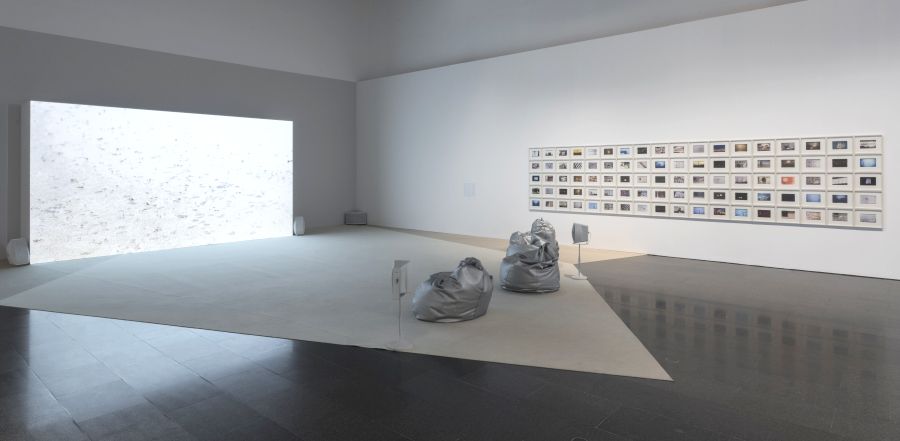Melanie Smith
Even though her work reflects on painting, throughout her career she has ranged between different languages such as photography, video, cinema, installation and intervention in public spaces, achieving a framework in which the different supports interact " to create heterogeneous structures, rich in meanings and with which the artist proposes constant re-readings of the notion of modernity and her plastic explorations in Latin America –particularly in Mexico– to cast a critical, audacious and propositional look on them ”(Teresa Vicencio: Melanie Smith , Impossible red square pink - Talleres de Artes Gráficas de Palermo, Madrid, 2011).
In this way, she focuses on reflecting on color, the city, representation and the everyday, rereading certain gestures typical of the historical avant-garde and post-avant-gardes in order to reflect and expand the notion of modernity in relation to the Latin American context in which it is registered.
María Elena
María Elena is an audiovisual project that continues the Fordlandia work carried out by the artist in 2013. María Elena is a mining town in the Atacama desert, an industrial settlement and a utopian project that exhibits a complex relationship between nature and modernity. Linked to the mining company to produce saltpeter (potassium nitrate) –property of the Guggenheim family in the 1920s–, the place is exposed in this project above all from the violence generated in the surrounding areas of the industrial sector, and how these have determined its history and its present. Smith's work addresses the effect of British exploitation and its impact on the landscape, as a way of showing the effects of the colonizing dynamics sustained by capitalism, as well as the labor exploitation that it involves. Following the artist's aesthetic style, the work is visually articulated through relationships between images that mix the body with abstractions and radical changes in scale.
The video and photographic images resulting from the project are the result of an extensive collaborative work over three years, in the process of which the sustained dialogue between curatorship and artistic authorship was dynamic. The project involved research visits to the site and to collaborating institutions and the collection of images and audios for the preparation of sketches and notes. Based on this material, the planning and execution of the filming was carried out, which resulted in the final audiovisual piece (these trips implied the realization of other activities such as Melanie Smith's visit to Santiago de Chile for a meeting with Academics at the Alberto Hurtado University and a conference at the Museum of Visual Arts in Santiago)
The filming process lasted approximately 25 days, in which various locations and files were recorded. It had the collaboration of a series of institutions, such as the Regional Museum of Antofagasta and the Private Collection of the Antofagasta- Bolivia Railway.
The work, from the approach to the place, is assembled in the form of a non-linear palimpsest: it does not have a single meaning, nor a clear beginning nor end. In the process, the images accumulate from the intuitive, the pulse of the place and a sensitivity that privileges the capture of its pictorial dimension (colors, textures), elements of the landscape that go from the micro to the macro and vice versa.
These images, which always privilege the fragmented representation of the landscape through specific visual elements, were articulated as a composition only later in the post-production. This edition allows the place to be visualized from details that take it away from the notion of the postcard. The project aims to connect, by means of a filmic piece, raw landscape, memory, testimony and history, seeking to activate a differentiated register of the moving image. Starting from the tension between the accident and the improvisation of the trip, against the narrative and stylistic structures of the cinema (the shot, the fiction, the documentary, etc.), an attempt is made to collide the documentary and the fiction and thus produce a moment of critical distancing from the landscape, as a visual and plastic genre typical of the western modernizing gaze.
Bio
Melanie Smith (Poole England, 1965), studied at the University of Reading, and settled in Mexico since January 1989.
Her work has been exhibited in important institutions such as P.S. 1 and MoMA (New York); the UCLA Hammer Museum (Los Angeles); the Institute of Contemporary Art (Boston); Tate Liverpool, Tate Modern and South London gallery (London); Lima Art Museum; Tamayo Museum, University Museum of Contemporary Art and El Eco Experimental Museum (Mexico City), and the Monterrey Museum, the Hamburger Bahnhof (Berlin); the 54th Venice Biennale (Italy); Milton Keynes Gallery (UK), The Contemporary Art Center (Vilnius); and the Boijmans Van Beuningen Museum (Rotterdam), among others.
Her solo exhibitions include "Parres" (Tate Britain, 2006); "Six steps to reality" (Museum of Contemporary Art of San Diego); “Parres” Miami Art Museum, and “Spiral city and other artificial pleasures” a retrospective that traveled from the University Museum of Science and the Arts (MUCA) in Mexico City to The Lab (Denver, 2008), the MIT in ( Boston, 2009), “Farce and Artifice” (Museum of Contemporary Art of Barcelona, 2018).
She has produced two artist books: Spiral city and other artificial pleasures (2006) and Parres (2008).

